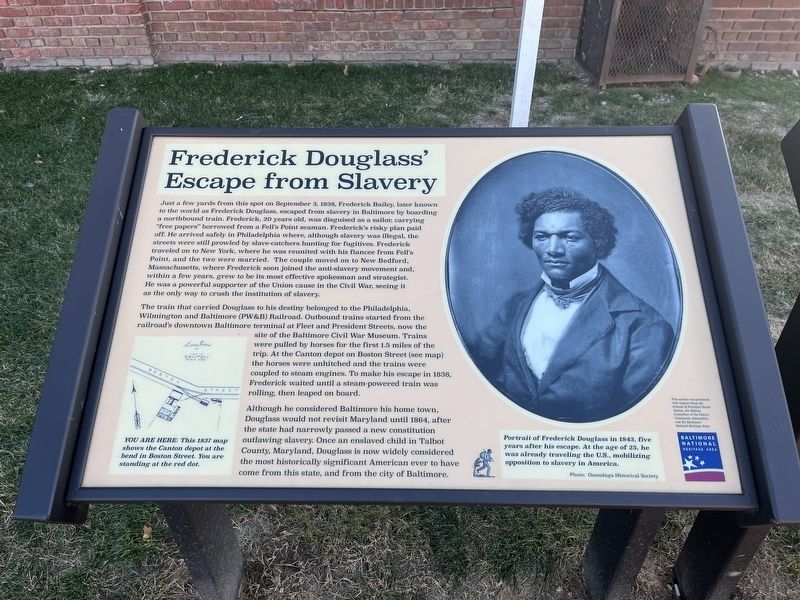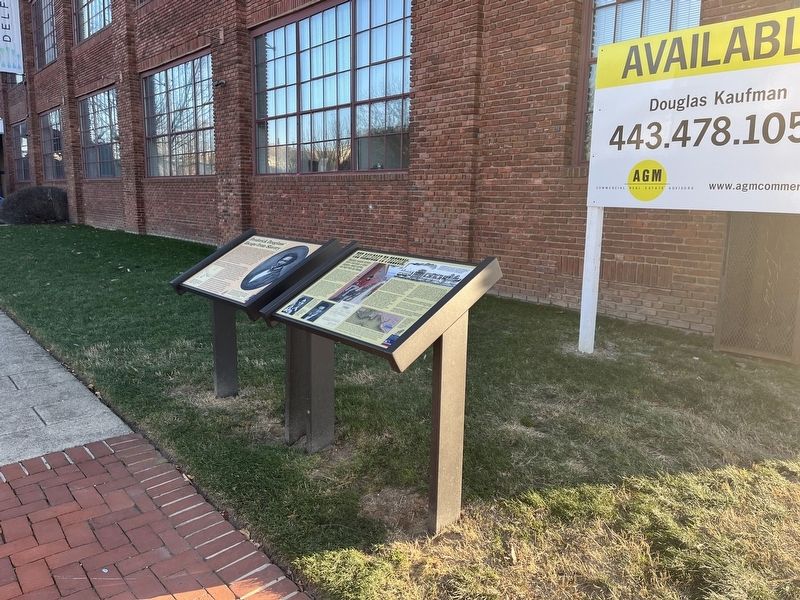Canton in Baltimore, Maryland — The American Northeast (Mid-Atlantic)
Frederick Douglass' Escape from Slavery

Photographed By Devry Becker Jones (CC0), December 24, 2022
1. Frederick Douglass' Escape from Slavery Marker
Just a few yards from this spot on September 3, 1838, Frederick Bailey, later known to the world as Frederick Douglass, escaped from slavery in Baltimore by boarding a northern train. Frederick, 20 years old, was disguised as a sailor, carrying "free papers" borrowed from a Fell's Point seaman. Frederick's risky plan paid off. He arrived safely in Philadelphia where, although slavery was illegal, the streets were still prowled by slave-catchers hunting for fugitives. Frederick traveled on to New York, where he was reunited with his fiancee from Fell's Point, and the two were married. The couple moved on to New Bedford, Massachusetts, where Frederick soon joined the anti-slavery movement and, within a few years, grew to be its most effective spokesman and strategist. He was a powerful supporter of the Union cause in the Civil War, seeing it as the only way to crush the institution of slavery.
The train that carried Douglass to his destiny belonged to the Philadelphia, Wilmington and Baltimore (PW&B) Railroad. Outbound trains started from the railroad's downtown Baltimore terminal at Fleet and President Streets, now the site of the Baltimore Civil War Museum. Trains were pulled by horses for the first 1.5 miles of the trip. At the Canton depot on Boston Street (see map) the horses were unhitched and the trains were coupled to steam engines. To make his escape in 1838, Frederick waited until a steam-powered train was rolling, then leaped aboard.
Although he considered Baltimore his home town, Douglass would not revisit Maryland until 1864, after the state had narrowly passed a new constitution outlawing slavery. Once an enslaved child in Talbot County, Maryland, Douglass is now widely considered the most historically significant American to have come from this state, and from the city of Baltimore.
[Captions:]
You are here: This 1837 map shows the Canton depot at the bend in Boston Street. You are standing at the red dot.
Portrait of Frederick Douglass in 1843, five years after his escape. At the age of 25, he was already traveling the U.S., mobilizing opposition to slavery in America.
Erected 2021 by Friends of President Street Station, the History Committee of the Canton Community Association, and the Baltimore National Heritage Area.
Topics. This historical marker is listed in these topic lists: Abolition & Underground RR • African Americans • Railroads & Streetcars • War, US Civil. A significant historical date for this entry is September 3, 1838.
Location. 39° 16.697′ N, 76° 34.579′ W. Marker is in Baltimore, Maryland. It is in

Photographed By Devry Becker Jones (CC0), December 24, 2022
2. Frederick Douglass' Escape from Slavery Marker
Other nearby markers. At least 8 other markers are within walking distance of this marker. The Railroad to Freedom (here, next to this marker); Historic Canton (about 700 feet away, measured in a direct line); a different marker also named Historic Canton (about 700 feet away); a different marker also named Historic Canton (about 800 feet away); Korean War Memorial (approx. 0.2 miles away); a different marker also named Historic Canton (approx. 0.2 miles away); The Harris Creek Rain Garden (approx. 0.2 miles away); Baltimore Regional Trail (approx. ¼ mile away). Touch for a list and map of all markers in Baltimore.
Credits. This page was last revised on December 24, 2022. It was originally submitted on December 24, 2022, by Devry Becker Jones of Washington, District of Columbia. This page has been viewed 311 times since then and 57 times this year. Photos: 1, 2. submitted on December 24, 2022, by Devry Becker Jones of Washington, District of Columbia.